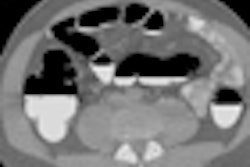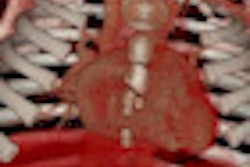VIENNA - Ultralow-dose CT appears to be sufficient for diagnosing complex fractures in pediatric patients, according to research from Germany presented at the 2010 European Congress of Radiology (ECR).
Researchers from the University Clinic of Schleswig-Holstein in Kiel found that scanner settings of 120 kVp, 11 mAs, and 1.5 pitch could yield a diagnostic success rate of 96% compared with a full-dose scan, but with a volume CT dose index (CTDIvol) of 0.48 mGy.
"That is comparable to the dose of plain-film radiography, and is 10% of the dose of the standard [CT] trauma protocol," said presenter Dr. Joerg Moritz.
Conventional radiography is typically used for pediatric trauma cases, but complex fractures can require additional imaging. While CT provides excellent delineation of bony structures and short examination times, these benefits come with a high load of radiation -- which is not desirable for pediatric patients.
To ascertain whether ultralow-dose CT could be sufficient to diagnose pediatric fractures, the German research team scanned 51 limb bones of dead young pigs at 36 different dose levels with systematic alteration of tube voltages (120, 100, or 80 kVp), tube current (100, 50, 40, 30, 20, or 11 mAs), and pitch factors (0.9 to 1.5).
The bones had either a minimal fracture, a complex fracture, or no fracture. Each of the specimens was scanned using an investigational configuration of a Somatom Definition 64 CT scanner (Siemens Healthcare, Erlangen, Germany) with an unlocked lower tube current limit.
The system's automatic tube current modulation was deactivated to avoid an automatic increase in tube current, Moritz said. Images were generated with a slice collimation of 64 x 0.6 mm and a 0.6-sec gantry rotation time and reconstructed using a B70 algorithm.
Two pediatric radiologists were asked to read each exam in a blinded and randomized fashion, using criteria such as the existence or absence of fracture, determination of the fracture type, and displacement. They also rated their diagnostic certainty on a scale of 0 to 3.
For the purposes of the study, the CT scans with the highest dose settings served as the reference standard, Moritz said. Success rate for each dose level for was determined by correct determination of the criteria and a diagnostic certainty rating ≥ 2. A success rate of ≥ 95% was considered sufficient for diagnosis.
While all dose levels were found to be adequate for characterizing dislocation and determining overall diagnostic accuracy, the two lowest settings (80 kVp, 11 mAs, and pitch 0.9 or 1.5) were insufficient for detecting fracture type. The lowest dose level setting was not usable for identifying fracture (91%), with the majority of misses being nondisplaced fractures.
"[The rest of the] protocols allowed us safe diagnosis of these complex fractures," he said.
By Erik L. Ridley
AuntMinnie.com staff writer
March 7, 2010
Related Reading
CT doses, widely variable in Europe, are reduced by staff efforts, March 6, 2010
High pitch equals low dose in coronary CT angiography, March 4, 2010
320-row CT minimizes dose in pediatric abdominal studies, March 3, 2010
Study finds wide variations in global pediatric CT dose, February 25, 2010
Image Gently achieves global reach by 2nd anniversary, February 25, 2010
Copyright © 2010 AuntMinnie.com





















